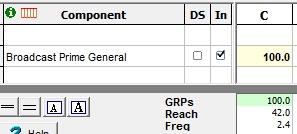Doublespotting
Why would an advertiser put two commercials in the same commercial pod? Some possibilities:
| ❖ | Boost awareness of the ad |
| ❖ | Reinforce the message of the ad |
| ❖ | Tell a story with one message opening, and another concluding ("bookends") |
| ❖ | Package two different 15" messages, perhaps for two distinct products into one 30" position ("piggybacking") |
| ❖ | Provide a humorous "one more thing" twist to the message |
| ❖ | Have a better chance at the first and last positions in the pod (thought desirable by some) |
A simple way to estimate who will see such placements is to count the reach of a commercial, but to double the frequency. That is, we might assume that the reach is whatever the rating is, but to count it as two exposures rather than one. TView provides a way to roughly estimate such placements. Turn on the "Doublespot" column in the Table view (see What to Show in the Table View). That adds a new "DS" column to the Table. Check the DS box for a media line that is to carry doublespot positions. Here's an example, with "DS" off, and then on:


The value of a doublespotting tactic has diminished as more homes have and use DVRs. Plus, since DVR usage makes it less common that a person who sees one of the messages will also see the other, the value of this simple estimate is diminished as well. Even so, it may serve as a rough guide to audience patterns.
